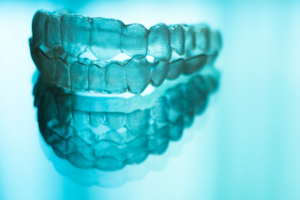Let’s get one thing straight. Straight is a concept that’s all over our language. From having our facts straight, to keeping a straight face, the idea of straight has become an ideal to aim for. Straight arrows. Straight pictures on the straight walls. And, of course, straight teeth.
 But what if the teeth you have aren’t as straight as they could be? Or as straight as you’d like them to be? Is there something you can do about it? Something other than metal braces with wires and tiny rubber bands, that is. The straight answer is yes. Nowadays there is an alternative to metal braces that can give you the straight teeth you want without the pain and problems of metal braces. It’s a clear plastic aligner and we offer them at Stiles Dental Care.
But what if the teeth you have aren’t as straight as they could be? Or as straight as you’d like them to be? Is there something you can do about it? Something other than metal braces with wires and tiny rubber bands, that is. The straight answer is yes. Nowadays there is an alternative to metal braces that can give you the straight teeth you want without the pain and problems of metal braces. It’s a clear plastic aligner and we offer them at Stiles Dental Care.
What are Clear Plastic Aligners?
A clear plastic aligner is, basically, just what the name implies: a clear dental device made of plastic that can be used to realign – i.e., straighten – slightly crooked teeth or a mildly misaligned bite. In other words, an aligner is a lightweight, practically unnoticeable alternative to the bulky, uncomfortable, and obvious-to-anyone metal braces many of today’s adults had, or at least saw on their friends, in childhood. They work exactly the way traditional metal braces work.
How Clear Aligners are Similar to Metal Braces
Like metal braces, an aligner can straighten crooked teeth, correct a misaligned bite, and push teeth together to eliminate a gap. Like metal braces, while you wear an aligner, it uses a gradually increasing force to move your crooked teeth into a new place in your mouth. In fact, as far as what they do and how they do it, aligners and metal braces are identical.
How Clear Aligners are Different from Metal Braces
But the way in which they are not alike, is what makes aligners a popular choice for straightening teeth that are a little out of line, or to fill a small gap in an otherwise wonderful smile. Like metal braces, each aligner is custom fabricated for your mouth and your teeth. Unlike metal braces, which are fastened to your teeth within your mouth, an aligner is a separate device that’s completely removable.
Brushing and flossing in the morning? Your aligner is easy to take out during your daily oral hygiene. Eating breakfast? Or lunch? Or dinner? Don’t worry. You can remove it whenever you’re eating or drinking, as long as you rinse your mouth and brush before putting it back in.
Another welcome difference? A clear aligner is more affordable for most people than a set of traditional metal braces. So that leaves only one question: does a clear, plastic device you can take in and out really perform as well as traditional metal braces? Again, the straight answer is yes.
Can a Clear Plastic Device Really Straighten Teeth?
It’s a well-accepted fact that no one – and nothing – in life is perfect. If your teeth were perfect, no straightening would be needed. So, even though an aligner can give you straighter teeth than you had before, it isn’t perfect, either. A clear aligner is a fast, effective, and discrete way to adjust teeth that are slightly misaligned or fill a small gap between teeth. Aligners are used for situations that don’t require jaw realignment or oral surgery. And they are used to adjust visual teeth (the ones people can see when you smile) and do not extend all the way to the back of your mouth. An aligner works on your teeth in a sequential, two-part procedure consisting of an active treatment phase followed by a passive treatment phase.
The Active Phase
In the active phase, as your wear your aligner, it applies a small amount of continuous pressure to your teeth, causing them to move very slightly over a period of time. The gentle pressure is hardly noticeable to you, but your teeth react to it by moving toward the positions they’re intended to eventually occupy.
The Passive Phase
Once they are in the position you and your dental team have decided on, there is a passive phase. At this time, you will switch to a retainer, which is very much like an aligner, but which applies no pressure. The retainer’s job is to hold the newly relocated teeth where they need to be as they heal. You’ll continue to wear your retainer on a permanent, decreasing schedule even after your teeth are healed.
One thing to note is that “getting an aligner” is not a one-time event. Aligners are worn about 20 hours a day, every day for up to two weeks. The length of time depends on how much adjustment your teeth need. After each usage period, we’ll check your teeth to determine how well the device is working and give you a new device to fit your teeth’s new position. Most patients need several device changes before the desired level of adjustment is reached.
Worn consistently, a professionally designed and monitored aligner can straighten your teeth as well as metal braces. And even though it can’t fix every issue, an aligner can make getting the smile you’ve always wanted easier, and likely less costly, than with traditional metal braces. So, if you’re looking to get your teeth straightened out, contact us for a straight path to the straighter teeth you’ll love.
